Quality of the Environment in Japan 1990
2. Measures Against Nitrogen Dioxides Pollution
(1) Basic Direction of Measures Against Nitrogen Dioxide Pollution
As measures against nitrogen dioxide pollution, areawide total pollutant controls whereby the total emission is controlled for each factory are made in Tokyo and two other areas in addition to the strengthening of emission controls and the expansion of facilities for which controls are invoked.
As regards motor vehicles, measures for automobile traffic, such as physical-distribution measures to curb truck trips with an increased efficiency of commodity forwarding and measures to encourage the introduction of less-polluting automobile have been carried out, in addition to the strengthening of controls on emissions from individual automobiles themselves.
Nonetheless, the concentration of nitrogen dioxide deteriorated both in fiscal 1966 and 1967 primarily in major urban areas, as we have seen in Chapter 3, and in fiscal 1988, the concentration remained virtu-ally at the same level as in fiscal 1987. This level was almost the same as in fiscal 1978 when the worst concentration was registered, and it is now an urgent task to cope with it. On future concentrations, some improvements may be anticipated, but it is projected that it would be difficult to achieve environmental quality standards, primarily at auto-mobile exhaust gas monitoring stations, only with conventional mea-sures. For this reason, it is necessary to implement the following measures in a comprehensive and powerful manner, let alone cuts in emissions from automobiles.
The first thing is to reduce emissions from automobiles. In particular, there is the need to further reduce emissions with priority given to diesel vehicles which have significantly increased in recent years and from which large quantities of nitrogen oxides are emitted.
Second, it is necessary to powerfully encourage a shift to vehicles with few emissions of nitrogen dioxides. In particular, as the prolonged life span of trucks and buses has become a major factor to check improvements in air pollution caused by nitrogen dioxides, it is impor-tant to encourage a shift to vehicles which satisfy the latest regulations. As for vehicles for which gasoline and diesel engines are concurrently used, there is the need to study the effects produced by economic factors, such as differentials between fuel prices.
Third, there is the need to reinforce measures for the develop-ment and introduction of less-polluting vehicles. In addition to the reduction of exhaust gas per automobile--the reduction that has been stepped up in the past, it is necessary to disseminate less-polluting automobiles in large numbers and settle their position in society as a major means of transit from a perspective of reducing exhaust gas from automobiles as a whole. For this, there is the need to powerfully step up research and development on improvements in the performance of electric cars, methanol cars, natural-gas cars and other less-polluting vehicles, expand their use and reduce their costs at the same time and build a social environment for their massive introduction.
Fourth, it is necessary to powerfully step up improvements, such as in the urban structure. In other words, in order to curb the coming of trucks into the hubs of major cities, there is the need to promote the relocation of truck terminals, markets, warehouses and other physical-distribution facilities to the suburbs and the move to appropriate sites of factories and business establishments which set off massive automobile trips, and at the same time to develop bypasses and loops which will contribute to the detouring and dispersion of traffic which is to go into city centers while taking account of the conservation of the environ-ment. It is also necessary to step up measures on the road structure, such as the development of belts of trees and other belts of environmen-tal facilities, and comprehensive parking measures.
Fifth, there is the need to work for improvements in the transport system. Particularly, it is important to work for the use of transport systems which may substitute for long-distance trucks, and it is neces-sary to encourage the utilization of systems to forward cargoes by rail, such as container transport systems and piggyback systems whereby trucks are transported on gondola cars.
As for medium-and long-distance transport, there is the need to step up the introduction of joint forwarding and joint cargo pickup and delivery and the utilization of rail and marine containers. Moreover, it is also necessary to step up studies based on new thoughts, such as on the methodological feasibility of curbing the total quantity of automo-bile exhaust gas for each community as a whole in major urban areas, and to work for their gradual realization while striving for a social consensus.
In addition to those measures, there is the need to work for thoroughgoing emission controls on factories and business establish-ments, etc., and to implement measures, such as temporary seasonal measures against air pollution which are accompanied by effective campaigns for the introduction and dissemination of regional air-conditioning systems and the promotion of the utilization of waste heat and natural energy.
Of all those measures, the Central Council for Environmental Pollution Control, acting on controls on automobiles themselves in 1, above, filed a recommendation in December 1989 "Concerning Measures to Reduce Automobile Exhaust Gas." In the recommendation, two targets are suggested--a short-term target which is to be accomplished somewhere between 1992 and 1994 on trucks, buses and diesel passenger cars and a long-term target which is to be accomplished in 10 years at the latest, and it is considered necessary to eventually realize a 30-60% reduction from the present emission levels.
Particularly as regards direction injection-type diesel trucks, it is suggested in the recommendation that large-scale reductions be worked out, such as 38% for large-sized ones and 65% for medium-sized ones, and it is considered necessary that controls on both direction-injection and indirect-injection types be integrated by lowering the emission levels of direct injection-type diesel vehicles to those of indirect injection-type diesel vehicles. In the future, there is the need to strengthen controls in line with this recommendation.
As regards substitution by vehicles which satisfy the latest con-trols in 2, above, it was decided that new measures for cuts of the automobile acquisition and other taxes be taken starting in 1990 when vehicles which satisfied the latest controls were purchased after old types of trucks and buses before the 1979 series of controls were disused.
(2) Measures Against Stationary Sources
a. Implementation of Nationally Uniform Emission Controls
Nationally uniform emission controls on nitrogen oxides from stationary sources have been strengthened and subject facilities expand-ed four times since the first series of emission controls in August 1973. In September 1985, furthermore, controls on small-sized boilers were started. In October 1987, gas turbines and diesel engines were added as control subjects. Controls were begun on new facilities in February 1988 and existing facilities in February 1990.
b. Implementation of Areawide Total Pollutant Controls
(a) Introduction of Areawide Total Pollutant Controls
For areas where factories and business establishments are con-centrated and it is deemed difficult to maintain environmental quality standards with emission controls on each facility to generate smoke and soot, the Ordinance for Execution of the Air Pollution Control Law was partially amended in June 1981 to introduce a system of areawide total pollutant controls on nitrogen oxides. Designated for total pollutant controls were three areas--Tokyo's 23 wards and other areas, Yoko-hama City and other areas and Osaka City and other areas--for which it was considered particularly urgent to implement measures for required reductions for the maintenance of environmental quality stan-dards.
As regards Nagoya City and other areas where areawide total pollutant controls were put on ice and Kita-Kyushu and other areas and Kobe City and other areas which decided to continue studying the advisability of implementing them, the local governments are striving by themselves to promote measures against nitrogen oxides under an operating procedure and so on.
(b) Implementation of Areawide Total Pollutant Controls, Etc.
In three areas designated for areawide total pollutant controls in June 1981, areawide total pollutant controls were begun in 1982. As of the end of March 1985, areawide total pollutant controls were exer-cised on existing factories and business establishments.
c. Development of Technologies to Reduce Emission of Nitrogen Oxides
The technologies designed to reduce the emission of nitrogen oxides from stationary sources include those to desulfurize smoke and low NOX combustion technologies, and their development and other factors have been surveyed since fiscal 1975 to come grips with the picture.
The development of low NOX combustion technologies in recent years is remarkable. With the adoption of two-stage combustion, low NOX burner and other methodologies, combustion technologies of the sort with which a considerable degree of effect is expected on reduc-tions of the nitrogen oxides emission are already disseminated.
The installation of smoke desulfurizing systems and their proces-sing capacity has steadily increased as indicated in Fig. 5-2-2. A check of their installation indicates that the selective catalytic reduction method is mostly used. Other methodologies include selective non-catalytic reduction and other methods.
As regards small facilities for the business performance and household combustion devices, which do not fall under the category of "sooty smoke generating facilities" defined in the Air Pollution Control Law, the quantity of nitrogen oxides generated from them in major cities cannot be ignored. For this reason, studies are under way on the introduction of measures, such as the setting of technical target values and commendation on quality NOX equipment, to reduce their quantity. Systems with few emissions of nitrogen oxides are developed with the introduction of low NOX combustion technologies.
Fig. 5-2-2 Installation of Exhaust Desulfurization Facilities by Year
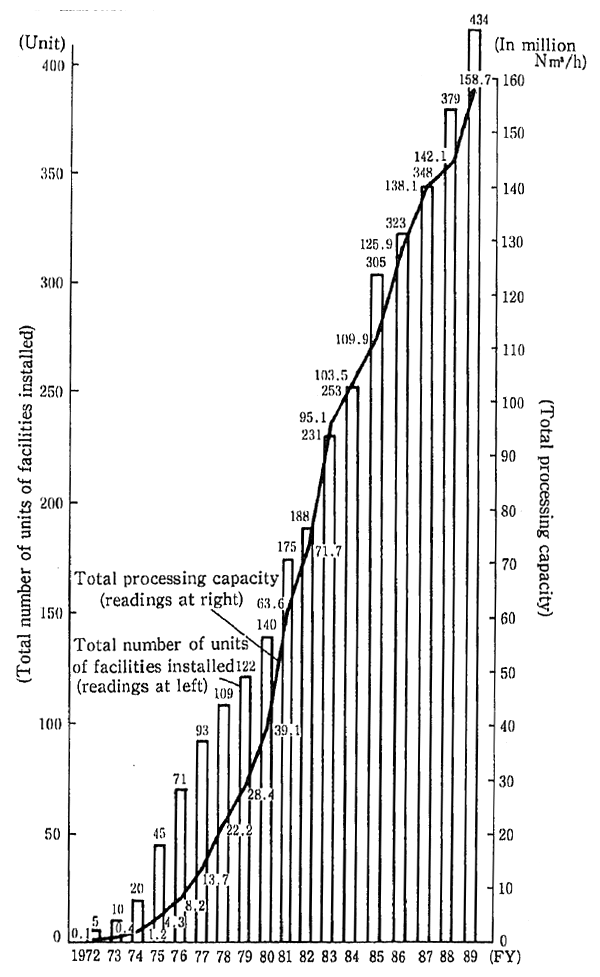
Remarks: 1. Surveyed by the Environment Agency.
2. The figures for FY1984 and the subsequent years are based on the reported data pigeonholing project associated with facilities which emit soot.
3. The figures for FY1982 and the preceding years are those as of January 1 of the given year, whereas those for FY1983 and the subse-quent years are those as of March 31 of the given year.
(3) Measures Against Automobile Exhaust Gas
Controls have been gradually reinforced on nitrogen oxides emit-ted from automobiles, but in major cities and other areas where there is much volume of automobile traffic, it has become necessary to further reduce emissions, so that there is the need to step up to a further extent comprehensive measures, such as traffic management and improve-ments in the urban structure, let alone measures to cope with individual sources for automobiles (for details, see Section IV).
In addition to the aforementioned measures, it is decided--as a new method to prevent health damage by reduction of air pollution of nitrogen oxides and other chemicals--to carry out a wide variety of projects which will contribute to improvements in the global atmo-spheric environment with the fund established in the Pollution-Related Health Damage Compensation and Prevention Association as a finan-cial source according to the revision of the Pollution-Related Health Damage Compensation Law, as will be referred to in Chapter 8.
Under the amended law, a wide variety of projects are promoted, such as the dissemination of electric and other low-pollution automo-biles by local governments and other institutions, the encouragement of a shift to vehicles which satisfy the latest controls and other vehicles with little exhaust gas, and the development of trees capable of purify-ing the atmosphere.
(4) Measures Against Nitrogen Oxides in Major Urban Areas
Despite the implementation of the aforementioned various mea-sures, air pollution with nitrogen oxides in major urban areas remains serious.
A check of the concentration of nitrogen dioxide in fiscal 1988 in the three areas where areawide total controls on nitrogen oxides were exercised indicates that the annual mean remained virtually at the same level as in the preceding fiscal year, and the rate of achieving environ-mental quality standards was not satisfactory, 51.0% for air pollution monitoring stations and 11.3% for automobile exhaust monitoring stations. A projection of the emissions of nitrogen oxides by source reveals that the rate of emissions from automobiles stood at 67% in Tokyo's Special Wards and other areas, 32% in Yokohama City and other areas and 47% in Osaka City and other areas.
On the basis of those conditions, the Environment Agency for-mulated an Intermediate-Term Projection of Measures Against Nitro-gen Oxides in Major Urban Areas in December 1985 and a New Intermediate-Term Projection of Measures Against Nitrogen Oxides (hereinafter referred to as the "New Intermediate-Term Projection") and has promoted systematic and comprehensive measures on the basis of new prospects. Under the New Intermediate-Term Projection, a future projection of pollution in fiscal 1993, and on the basis of this projection, the direction of measures is shown. On this basis at present, a wide variety of measures, including three centerpieces--measures on individual automobiles themselves, measures on automobile traffic and measures on stationary sources--are being stepped up for an early attainment of environmental quality standards.
For curbs on the emission of nitrogen oxides, the essential is to take measures against sources. With this in mind, the Director-General of the Environment Agency inquired the Central Council for Environ-mental Pollution Control in December 1989 about the measures for reductions of the emission of automobile exhaust gas. After assiduous studies, the council came out with a recommendation in December 1989 in light of the prevailing serious nature of air pollution came out with strict reduction targets, those for a short term of less than five years and a long term of more than 10 years, primarily for diesel vehicles in regard to nitrogen oxides and other chemicals.
In the future, the Environment Agency will go through required formalities and gradually attain short-term targets with the coordina-tion of related ministries and agencies. It will also strive to attain long-term target values as early as possible while encouraging automa-kers, etc., to develop technology.
In order to reduce the total emission of nitrogen oxides from automobiles in addition to the strengthening of controls on the individ-ual automobile exhaust gas, the agency is also making positive efforts, such as with the utilization of preferential tax measures and the fund established under the Pollution-Related Health Damage Compensation Law in regard to the encouragement of a shift to vehicles which satisfy the latest controls and other low-pollution vehicles and the introduction and dissemination of electric and other low-pollution vehicles.
With the effects of reductions in automobile exhaust gas accord-ing to the aforementioned recommendation made by the Central Council for Environmental Pollution Control, it is projected that environmental quality standards will be almost completely attained at air pollution monitoring stations when it comes to air pollution with nitrogen oxides in major urban areas, but it is projected according to calculation on a trial basis that full improvements may not be attained at automobile exhaust monitoring stations as against environmental quality standards. With this in mind, the Environment Agency is studying measures to curb the total quantity of gas emitted from automobiles for each community as a whole.
In addition to those measures, the Temporary Measures Against Seasonal Air Pollution, which include the rationalization of the tempera-ture of air-conditioning systems and curbs on the number of cargo pickup and delivery vehicles have been in force since fiscal 1988 to cope with high concentrations of air pollution in winter. With December designated as the Month for the Promotion of Air Pollution Prevention, dissemination and enhancement programs on the prevention of air pollution are evolved for the people's sake.
3. Measures Against Particulate Matter
Particulate matter regulated in the Air Pollution Control Law is divided 2 classes. One is "soot and dust" generated from combustion fuel, and the other is discharged or scattered from mechanical treatment such as crushing and classifying or piling of materials. In addition, the law regulates particulate generated by automobiles (diesel smoke) as particulate matters."
(1) Measures Against SPM
Environmental quality standards were formulated for SPM in May 1973. The rate of attaining those standards has gone up but is still low, and it is an urgent task to work out measures. Given this situation, comprehensive surveys and analyses are under way on SPM.
Up to now, surveys on the generation of soot and dust, and on the secondarily generated particles (particles which grow as sulfur dioxides and other gaseous matter are affected by physical and chemical changes), and comprehensive analyses on the environmental concentra-tion of SPM have been conducted. In December 1987, methods to analyze and project pollution with SPM were formulated. Surveys and studies have also been performed since fiscal 1989 with a panel for studies on methods to reduce SPM in order to formulate measures which ought to be taken for the time being.
As regards particulate matter which is generated by the automo-biles, target values for reductions in particulate matter as a whole are set in addition to those for black diesel smoke in response to a recom-mendation made by the Central Council for Environmental Pollution Control in December 1989 (Table 5-4-9).
(2) Measures Against "Soot and Dust" and "Particulate"
As regards soot and dust, emission standards are formulated, depending on the type and scale of the facility. Furthermore, in areas where facilities are congested with serious pollution, special emission standards, which are more strict, are formulated for new and additional facilities. In October 1987, gas turbines and diesel engines were added as subjects on which those controls would be exercised. Controls have also been exercised on new facilities since February 1988 and on existing facilities since February 1990.
Concerning general particulate (particulate other than "specified particulate" was defined as "general particulate" with the Air Pollution Control Law revised in June 1989. As for specified particulate, see "6-(1) Measures Against Asbestos."), standards were formulated on the struc-ture, use and control of dump yards, conveyers and other places where dust is generated.
(3) Measures Against Dust by Studded Tires
As dust is generated by the trips of automobiles equipped with studded tires, health hazards and aggravation of living environment have become a grave issue especially in primary snowy and cold dis-tricts in recent years.
Given this situation, the Environment Agency began to conduct fact-finding and other surveys on the effects on the environment by dust, particulate whirled up by the use of studded tires in fiscal 1982, and the findings were released in August 1988. According to the findings, the sedimentation of particulate in the lungs and lymphnodes and the fibrillation of some lungs were observed, and it was suggested in the findings that there was the need to continue working for curbs on the generation of dust.
On this score, there was the need to study measures while taking comprehensive account of a broad range of sectors, such as the paving of roads, traffic safety and the structure of tires. In 1983, a Liaison Council of Related Ministries and Agencies on the Problem of Studded Tires was established to exchange information and views.
Regarding local governments, the Environment Agency called on them to take measures for the time being in September 1983. At present, strategy plans are formulated, guidance on the use of studded tires is provided and other measures are taken in 13 prefectures: Aomori, Iwate, Akita, Yamagata, Fukushima, Niigata, Nagano, Gifu, Toyama, Ishik-awa, Fukui, Tottori and Shimane.
In Miyagi Prefecture and Sapporo City, ordinances incorporating controls on the use of studded tires and other measures were enacted in April 1986 and April 1987, respectively. In Hokkaido, ordinance of a similar kind was enacted. All these developments suggest that efforts are being made for promotion of efficient measures in view of the actual situation of each district.
In April 1989, an Administrative Liaison Council on Measures to Cope with Studded Tires was established by 23 related prefectures with a view to promoting measures to solve various problems which arise in conjunction with the use of studded tires. In August 1989, municipalities in the 23 prefectures established a Promotion Council for the Building of Studded Tire-Free Cities for the same purpose. With December designated as the Month for the Promotion of the campaign Against Studded Tires, a wide variety of campaigns was unfolded under the sponsorship of the two councils with support and cooperation of related ministries, agencies and organizations.
At the Environmental Disputes Coordinating Commission on June 2, 1988, an arbitration calling seven major tire makers in Japan for suspending production of studded tires since January 1991 and their sales since April 1991 came into force between the claimants (269 persons, including lawyers, in Nagano, Tohoku and Hokkaido) and the claimed (the seven makers). To smoothly get into a studded tire-free society, there is the need to further promote conventional measures, such as public enlightenment and guidance, the removal or melting of snow on the roads, the development and dissemination of substitute tires, and education on safe driving on the roads in the wintertime.
4. Measures Against Petrochemical Air Pollution
The concentration of photochemical oxidant exceeded environ-mental quality standards almost in every district across the country, and as situations where a warning had to be issued came out, depending on the weather condition, there is the need to come to accurate grips with the state of pollution and take appropriate measures.
(1) Occurrence of Photochemical Air Pollution
a. Issue of Warnings, Etc. Around the Country
In 1989, photochemical warnings (This warning is issued when the one-hour average of photochemical oxidant concentration is 0.12 ppm or higher and that the polluting state is considered to continue further in view of the weather condition at that time) were issued on 63 days in the aggregate, covering 17 prefectures. The number of days was small than last year, when the number of days when a warning was issued was relatively small, and represented a low level following the 59 days registered in 1981 (Table 5-2-3).
In the month-specific breakdown in 1989, the number of days with warnings issued was 7 days in May, 26 days in June, 12 days in July, 15 days in August, 2 days in September and 1 day in October, suggesting that it was particularly great in June.
Incidentally, the highest concentration of photochemical oxidant on the days with warnings issued was 0.193 ppm. No photochemical oxidant alarm (which is issued when the hourly values of photochemical oxidant concentration exceed 0.24 ppm and the condition is likely to continue from a meteorological point of view, although different criteria are applied by prefectures) was issued.
b. Breakdown of Areas with Warnings Issued
In the area-specific breakdown in 1989, the aggregate number of days with warnings stood at 33 in the Tokyo Bay area (Ibaraki Prefec-ture, Tochigi Prefecture, Gunma Prefecture, Chiba Prefecture, Tokyo and Kanagawa Prefecture) and 16 in the Osaka Bay area (Kyoto Prefecture, Osaka Prefecture, Nara Prefecture and Hyogo Prefecture). Those two areas accounted for about 80%.
Table 5-2-3 Trends in Aggregate Number of Days with Warnings Issued and Number of People Reporting About Damage (1985-89)

Remarks: Surveyed by the Environment Agency.
c. Number of Sufferers
The number of reported sufferers from photochemical air pollu-tion in 1989 (persons voluntarily reporting about subjective symptoms) was 36, which was drastically lower and an all-time low.
(2) Emergency Measures Against Photochemical Air Pollution
In order to secure weather data necessary to judge the issue of warnings, the Environment Agency has observed the weather at four points on Tokyo Bay and Osaka Bay where photochemical air pollution tends to occur in the summertime, offering weather information to related local governments. The Meteorological Agency analyzes and forecasts meteorological conditions which tend to give rise to photo-chemical air pollution at 19 meteorological observatories across the country and reports to local governments.
On the basis of those information and the date provided by monitoring stations, local governments issue a warning according to the Procedure on Emergency Measures Against Photochemical Oxidant and the like and ask persons responsible for the emission of smuts to reduce the emission of air pollutants and automobile users not to make unnec-essary trips by car. Besides, they evolve public-information activities and health care measures for residents.
(3) Measures for Curbs on Emission of Hydrocarbon
a. Emission of Hydrocarbon from Stationary Sources
On the basis of the findings of the grasp of actual emissions, assessment of technologies for the prevention of emissions and other studies done by a workshop on stationary sources of hydrocarbon, the Environment Agency in July 1982 decided "On the Promotion of Measures Against Hydrocarbon for the Prevention of Photochemical Air Pollution" to strengthen and promote measures for curbs on the emission of hydrocarbon from stationary sources. In line with this policy, the Environment Agency filed local governments and other related organizations with necessary requests for the updating of data on sources in March 1983 and worked for a further updating of data in fiscal 1989.
b. Emission of Hydrocarbon from Automobiles
On hydrocarbon emitted from automobiles, controls have been exercised since 1970, and in terms of LPG passenger cars, the emission of hydrocarbon per car under the fiscal 1975 controls dropped by 92% from the years when it had not been controlled.
5. Protection of Ozone Layer
In order to prevent depletion of the ozone layer, the Vienna Convention for Protection of the Ozone Layer (put into force on Septem-ber 22, 1988) and the Montreal Protocol on Substances that Deplete the Ozone Layer (put into force on January 1, 1986) were adopted. For an unerring and smooth implementation of those conventions, Japan promulgated a Law concerning Protection of the Ozone Layer through Control of Specified Substances and Other Measures" (hereinafter referred to as the "Ozone Layer Protection Law") in May 1988 (Fig. 5-2-4).
Fig. 5-2-4 Items Incorporated in Law Concerning Protection of Ozone Layer, Such as Regulations on Specified Substances
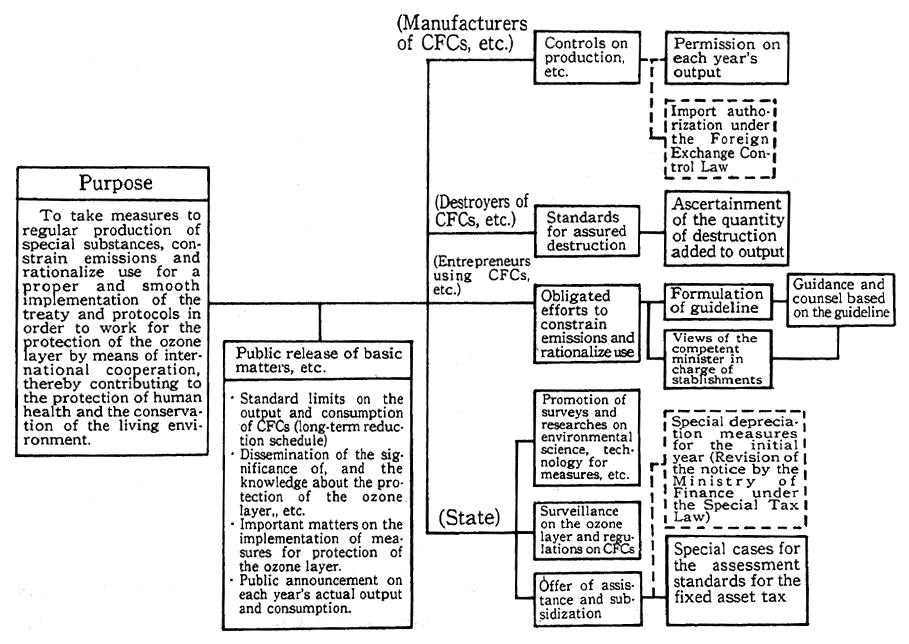
In accordance with the Ozone Layer Protection Law, notice was served on "basic matters" on January 4, 1989, providing the basic direction for measures to protect the ozone layer in Japan.
In order for Japan to positively grapple with air pollution on a global scale, organizational institutions were reinforced in the Environ-ment Agency, Ministry of International Trade and Industry and Meteor-ological Agency, and the following measures were implemented.
(1) Controls on Production of Specified CFCs, Etc.
In accordance with the Ozone Layer Protection Law, the produc-tion and consumption of five kinds of CFCs [chlorofluorocarbon 11, chlorofluorocarbon 12, chlorofluorocarbon 113, chlorofluorocarbon 114 and chlorofluorocarbon 115 (hereinafter referred to as "specified chloro-fluorocarons")] and three kind of halons (halon 1211, halon 1301 and halon 2402) specified by the Montreal Protocol were to be reduced in line with the reduction schedule contained in the Montreal Protocol (Fig. 5-2-5), controls on the production of specified CFCs were started in July 1989.
Fig. 5-2-5 Standard Limits on Output and Consumption of Specified CFCs Japan Must Abide by under Provisions of the Montreal Protocol on Substances Destroying the Ozone Layer
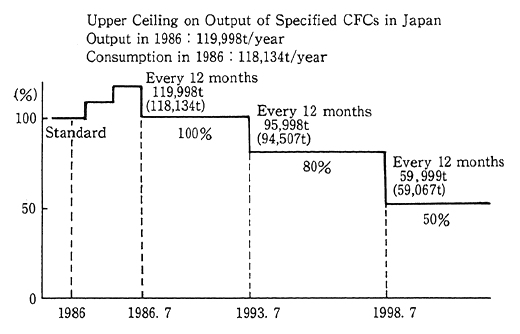
Remarks: The figures in parentheses represent consumption. Output numerically differs from consumption because the balance between net imports and exports and imports are deducted from output.
(2) Emission Control and Rational Use of Specified CFCs
As the Guidelines for Emission Control and Rational Use of Specified CFCs was promulgated on January 4, 1989 in order for entre-preneurs using specified CFCs to curb their emission and rationalize their use, attempts were made to let it be known and disseminated with the distribution of manuals and pamphlets. It was decided in the preced-ing fiscal year to designate July as the Month for the Promotion of the Rational Use of Specified CFCs for an unerring and smooth promotion of measures for the protection of the ozone layer, and the government united the private sector in its enhancement and propagation.
As regards facilities for the utilization of specified CFCs for cleaning purposes, for which attempts are made specifically under the guidelines to introduce for emission control and recovery facilities, tax measures, including special redemption for the corporation and income taxes as well as the setting of exceptions in the application of taxable standards for the fixed property tax ; and financial measures, such as low-interest loans available from the Japan Development Bank, Japan Environment Corporation and other institutions.
(3) Surveys, Researches, Etc. on Depletion of Ozone Layer
In order to reasonably protect the ozone layer, elaborate studies are being made on mechanisms for the depletion of the ozone layer by specified CFCs and other chemicals and the effects brought about by the depletion of the ozone layer. Models for the measurement by altitude of ozone with ozone laser radars and for the forecast of future ebbs and flows in the ozone layer are also being developed.
The development of technologies for the destruction of specified CFCs which are already used and the collection, updating and assess-ment of findings for the development have been performed.
(4) Further Reductions in Specified CFCs, Etc.
At the conference of the parties to the Montreal Protocol opened in May 1989, the workshop which was established according to the protocol is studying amendments in the protocol for the strengthening of controls and other purposes, while taking account of the Helsinki Declaration in which agreement was reached especially on a total phaseout of specified CFCs by the end of this century. In order to make positive contributions to this international study work, Japan is study-ing measures for further reductions in specified CFCs and other chemi-cals.
For encouragement of developing countries' involvement in the Vienna Convention and the Montreal Protocol, the Asia and Pacific Seminar on the Protection of the Ozone Layer was held in Tokyo in May 1989.
6. Other Air Pollutants
(1) Asbestos
Asbestos is used for many products as a useful substance, but as it has health hazards, such as carcinogenicity, it has become an urgent task to take measures for the prevention of air pollution and health hazards to man.
The Environment Agency has stepped up surveys and studies, such as on the concentration of asbestos in the environment and atmo-sphere since 1975. On the basis of those surveys and studies, the agency in fiscal 1987 performed surveys, such as on the concentration in the environment and atmosphere of asbestos in areas peripheral to such sources as factories for the production of asbestos and other goods and also on measures to cope with the sources of origin, and the Study Panel on Measures Against Asbestos which included experts assessed the findings of the surveys and studies. As a result, it turned out that the measured concentration of asbestos in areas peripheral to some fac-tories for the production of asbestos and other goods was tens to hundreds of times as high as in the general environment.
In case such a concentration continues in the future, the risk of pulmonary cancer and malignant mesothelioma would become relative-ly high, so that it was concluded that it was necessary to bring down the concentration of asbestos around factories to the range of concentra-tions where the World Health Organization (WHO) described as too low to detect the risk of pulmonary cancer and malignant mesothelioma for which asbestos is responsible.
With this in mind, the Central Council for Environmental Pollu-tion Control formulated a recommendation in March 1989 on the way institutions should basically be to prevent air pollution with asbestos which came out of factories for the production of asbestos and other products. Given this recommendation, the Law for a Partial Amend-ment of the Air Pollution Control Law was promulgated in June 1989.
Under the revised law, such particulate which includes asbestos and other matter which is likely to harm man's health are defined as specified particulate. In this conjunction, facilities which are responsible for the generation of specified particulate are defined as facilities responsible for the generation of specified particulate, and as measures to control specified particulate, provisions are formulated, such as for the filing of reports on the installation of facilities responsible for the generation of specified particulate, orders for changes in plans, the obligation to observe standards for controls on specified particulate, orders for improvements of pollution, and the obligation to measure the concentration of specified particulate.
The amended law came into effect on December 27, 1989. Of facilities where asbestos as specified particulate is offered for the manufacture of products containing asbestos, cutters and eight other facilities are designated as facilities responsible for the generation of specified dust, and controls under the Air Pollution Control Law are invoked for factories for the manufacture of asbestos and other prod-ucts.
As measures against asbestos other than controls on factories for the manufacture of asbestos and other products under the Air Pollution Control Law, surveys, on the dispersion of asbestos in the repair and demolition of buildings have started this fiscal year.
(2) Toxic Matter
Under the Air Control Law, (1) cadmium and its compounds, (2) chlorine and hydrogen chloride, (3) fluorine, hydrogen fluorine and silicon fluorine and (4) lead and its compounds are controlled as "toxic matter" which are generated from facilities responsible for the genera-tion of sooty smoke in addition to nitrogen oxides.
Emission standards for the toxic substances in (1) to (4) are formulated for facilities responsible for the generation of sooty smoke of sorts which are limited, depending on the kind of toxic substance. At facilities responsible for the generation of sooty smoke, particulate matter of the sorts which are generated for some other reasons are all controlled as "soot and dust."
(3) Uncontrolled Matter
From the standpoint of checking air pollution beforehand, sub-stances are selected one by one from uncontrolled substances about whose toxicity there is concern, and surveys are performed on the emission density and effects on the environment. The findings of the surveys indicate that there are no uncontrolled substances whose atmo-spheric concentration has to be immediately taken up as an issue, but as they are substances whose environmental impact is concern in a long-term perspective, there is the need to come to grips with trends in the environmental concentration, so that monitoring has been performed every other year on asbestos since fiscal 1985, formaldehyde and dioxins since fiscal 1986 and mercury from fiscal 1987, and monitoring was started in fiscal 1989 on organochlorine solvents.
(4) Global Warming
As for global warming generated by carbon dioxide, methane, dinitrogen monoxide and other chemicals, there is concern that the global environment and economy will be greatly affected, as changes in the regional characteristics of agricultural production and in their ecosystems will be brought about as global warming is responsible for changes in the climate, rises in the sea surface and changes in the content of water in the soil.
When the magnitude of projected effects are taken into account in regard to global warming, there is the need to energetically promote surveys and researches in inadequately clarified sectors, such as mecha-nisms for global warming, and at the same time to promptly embark upon practicable measures before it is too late to do so. Given this necessity, steady efforts are being made in the nation, such as a further promotion of energy-saving measures.
The Environment Agency has stepped up surveys and researches on mechanisms for warming, such as a clarification of the dynamics of dinitrogen monoxide and other greenhouse gases, let alone carbon dioxide, comprehensively assessed the scientific findings of the Working Group on Global Warming, studied the way of the response, and posi-tively taken part in international studies, including the Intergovern-mental Panel on Climate Change (IPCC) to reflect the findings.
Moreover, the Agency of Science and Technology, Ministry of Agriculture, Forestry and Fisheries, Ministry of International Trade and Industry, Meteorological Agency and other government institutions are also promoting required surveys and researches.
(5) Acid Rain
Acid rain has become an international issue, as it seriously affects lakes and marshes, forests and the like in North America and Europe. In Japan, there have been no reports on such damage, but as it is too late to take action after damage on the ecosystem comes to light, it is decided to carry out necessary surveys and researches, such as a clarifi-cation of mechanisms for the generation of acid rain, and to study measures on the basis of those findings.
In order to come to grips with the state and effects of acid rain in Japan, the Environment Agency conducted the First Survey on Measures Against Acid Rain from fiscal 1983 to fiscal 1987. As a result, it came to light especially that acid rain had fallen across the country with an annual mean level of 4 pH, and there is concern that if it continues to fall as at the present pace, impacts on the ecosystems may come to the fore.
Given this possibility, the Environment Agency has continued since fiscal 1988 to systematically perform the pilot monitoring of the atmosphere, closed water bodies and soil for surveillance, the analysis of rainwater components, the development of models on the generation of acid rain, and surveys and researches on impacts on the ecosystems.
Since fiscal 1988, the surveillance of acid rain has been conducted at 23 national monitoring stations, and in fiscal 1989, acid rain monitor-ing stations were established on offshore islands (Tsushima in Nagasaki Prefecture and Oki-Shima in Shimane Prefecture).
Moreover, studies are under way by the Ministry of International Trade and Industry, Meteorological Agency and other government institutions.
(6) Propagation and Enhancement, Etc.
In order to increase opportunities for residents to come in contact with, and take another look at, their close-by environment, as the role they should play by themselves for conservation of the local environ-ment has increased, a "star watching network" has been established since fiscal 1988, and with the involvement of local governments and other organizations, stars are observed to deepen the interest in the conservation of the atmosphere. In July 1989, the first National Conven-tion for Star-Visible Towns and Clear Sky-Assured Towns was held (in Ashibetsu City) to discuss about the promotion of measures for the conservation of the local environment and to make effective use of the local environment.
III. Development of Monitoring System
All-time monitoring of air pollution is indispensable to grasp degrees to which environmental quality standards are attained and to formulate measures to prevent air pollution. It also constitutes the foundation of administration on the conservation of the atmosphere.
(1) National Air Monitoring Network
To come to grips with the nationwide state of air pollution and obtain basic data necessary for the establishment of environmental quality standards and the formulation of pollution prevention programs, national air pollution monitoring stations and national environment background air monitoring stations are established.
The nationwide network of national air monitoring stations is shown in Fig. 5-3-1.
National air monitoring stations are established at 15 places in major districts across the country. Each monitoring station is equipped with a wide variety of measuring instruments to monitor sulfur dioxide, nitrogen oxides and other chemicals, and on the basis of those stations' findings, factors for air pollution are analyzed and clarified.
National environment background air monitoring stations are established at 8 places to come to grips with local conditions in areas other than already polluted districts in Japan's representative plains. Those monitoring stations are equipped with instruments to measure hydrogen sulfide and ozone, etc., in addition to the same kinds of measuring instruments as furnished to national air pollution monitoring stations.
A three-year program for the establishment of acid rain monitor-ing stations on offshore islands was started in fiscal 1989. They were established at Oki-Shima and Tsushima in fiscal 1989.
As regards automobile exhaust gas, national automobile exhaust monitoring stations are established at 3 places in Tokyo beside one in Maebashi City, Gunma Prefecture.
As part of the global-scale background air pollution monitoring network (BAPMoN) of the World Meteorological Organization (WMO), the Meteorological Agency is constantly observing at the Meteorologi-cal Rocket Observatory in Sanriku Town, Iwate Prefecture, the concen-tration of carbon dioxide, CFCs, dinitrogen monoxide and on-the-ground ozone, which are greenhouse gases deeply tied in with global warming, and the conditions of air pollution, such as the chemical analysis of precipitation and dust fallout.
Fig. 5-3-1 Location of State-Established Air Monitoring Stations
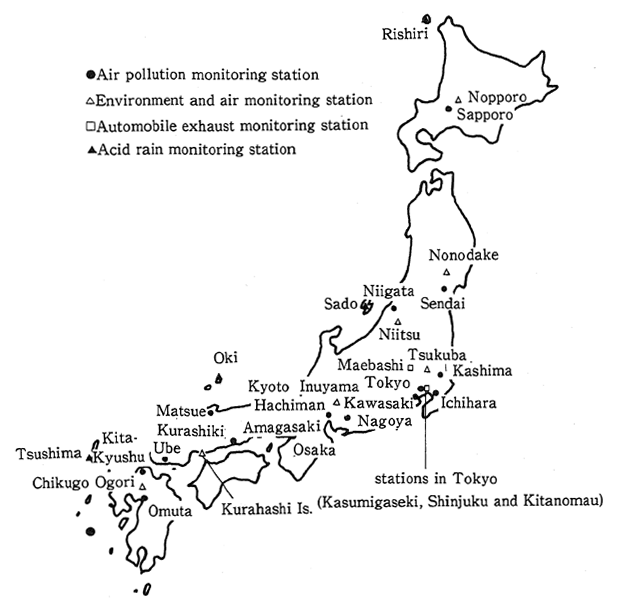
In relation to the protection of the ozone layer, the Environment Agency is monitoring the concentration of CFCs in the atmosphere in Hokkaido, in which the air is clean and which is regarded as represent-ing the background concentration of areas intermediate in latitude in the Northern Sphere, and also in the suburbs of major urban areas which are considered suitable to grasp measures for curbs on emissions and a rationalization of the uses.
The Meteorological Agency carried on the observation of ozone at four points in the country, which were part of the WMO's global ozone observation system (GO3OS) [Sapporo, Tateno (Tsukuba), Kago-shima and Naha] and at the Showa Antarctic Base, and began to observe ultraviolet radiation in order to clarify changes in the condi-tions of toxic ultraviolet rays at the Substratospheric Observatory (Tsukuba) in conjunction with the depletion of the ozone layer.
Moreover, in order to assess the role of oceans in the global environment, such as greenhouse gases and ozone layer disrupters, the agency has also started periodically observing carbon dioxide, methane, chlorofluorocarbons and dinitrogen monoxide in the seas around Japan and in the Western Pacific.
(2) Local Air Pollution Monitoring System
In the countryside, the governors of prefectures and the mayors of administrative ordinance-designated cities are constantly monitoring air pollution under the Air Pollution Control Law. In addition, monitor-ing is being made by other local governments.
Constant monitoring is made on the concentration of sulfur dioxide and the quantities of fuels used at the sources from which air pollutants are emitted, and the development of telemetric systems with which to transmit monitored data to the central monitoring center is being done by some local governments.
Incidentally, the State subsidizes the development of monitoring instruments necessary to prefectures and administrative ordinance-designated cities for monitoring, works for the sophistication of monitoring technologies and the systematic and priority development of monitoring systems which satisfy the increased efficiency. It also strives to modernize the facilities of local environmental pollution research institutes.
IV. Traffic Pollution--Present State and Measures
1. Comprehensive Promotion
(1) Outline of Issues on Traffic Pollution
a. Means of transport in Japan extremely rapidly developed through a period of postwar economic reconstruction and its subsequent period of high economic development. The development of sophisticated and diversified means of transport in the meantime have produced much in terms of social utility, on the one hand, and given rise to traffic pollution in areas around large-scale transport facilities and in other areas, on the other.
In major urban areas, the traffic volume has increased in conjunc-tion with the concentration of population and and industry, the growth of service industries and the development of buildings reserved for business operations. It has become all the more difficult to solve issues on traffic pollution as they are tied in with the urban structure, such as the interlining of various modes of transport to which full consideration to traffic pollution is not always paid, including the compatibility of transport facilities with the peripheral land use and reductions in the traffic volume.
b. In order to cope with traffic pollution, measures against sources, measures for transport facilities and measures for peripheral neighbor-hoods are being strenuously taken, while paying attention to air pollu-tion factors, noise and vibration, as classified by means of transport. Some achievements have been made in some areas, but there remain areas where problems may not be solved unless further measures are comprehensively implemented.
(2) Comprehensive Implementation of Measures Against Traffic Pollution
a. Road traffic pollution, exhaust gas, noise and vibration caused by the trips of automobiles are posed as issues. As a further increase is projected in the volume of automobile traffic, there is the need to further grapple with measures against nitrogen dioxides and other exhaust gases and those against noise and vibration. It is also necessary to promote comprehensive measures in a more forceful manner, includ-ing measures on individual automobiles themselves, such as the stren-gthening of emission controls and the dissemination of less-polluting vehicles; curbs on the traffic volume, such as by the rationalization of physical distribution; the development of bypasses and loops with con-sideration given to the conservation of the environment; the dispersion and smoothing of traffic flows, such as by the development of traffic control systems; the improvement of roads, such as by the installation of noise barriers; and the rationalized use of roadside land.
b. As regards measures against the noise of aircraft, it is decided to powerfully promote for the attainment of environmental quality stan-dards measures against sources, such as with the introduction of low-noise aircraft, and measures on the structure of airports, such as the move of runways.
Particularly in areas where environmental quality standards are not likely to be attained only with those measures, there is the need to carry out prevention measures, such as the installation of noise arresters for dwellings, for the time being. For areas where the noise is intense, there is the need to carry out systematic peripheral-land use measures, such as by shifting the land use from dwellings to the sort in which there will be few hazards from noise and by curbing new land utilization for dwellings.
c. As regards measures against the noise and vibration caused by Shinkansen trains, it is necessary to comprehensively step up measures for noise prevention and the peripheral land use, while measures against source are positioned as basic ones for the attainment of environmental quality standards.
Particularly as regards noise, the last year for the attainment of environmental quality standards is already gone for the Tohoku and Joetsu Shinkansen lines following the Tokaido and Sanyo Shinkansen lines, and it is decided to work for a steady implementation of the following measures for an early attainment of the environmental quality standards from now on.
(1) Promotion of measures against noise sources. which are positioned as basic measures
(2) Promotion of the construction of noise arresters in areas where the noise and vibration levels are in excess of the environmental standards
(3) Development and utilization of technology for the reduction of noise
(4) Rationalization of land use along Shinkansen lines (curbs on new land use for dwellings, location of public and other facilities less likely to be functionally affected by noise)
2. Measures Against Road Traffic Pollution
(1) Present State
a. In Japan, the concentration of population and industry in urban areas and rapid motorization evolved in the process where a sophisti-cated economic society was formed. Even a check of trends in the number of owned automobiles indicates that it rose from about 21.22 million at the end of fiscal 1971 by about 2.6 times to 55.14 million at that of fiscal 1988 (Fig. 5.4-1).
As things now stand, there are no signs that the evolution of motorization will slow down, and particularly in major urban areas and urban areas along trunk roads which form arteries of automobile traffic, air pollution and environmental disruption by noise and vibra-tion are caused by automobile traffic.
b. The findings of monitoring done by automobile exhaust gas monitoring stations established to come to grips with the conditions of air pollution along roads are shown in Section 1, Chapter 5, Part 2.
Fig. 5-4-1 Trends in Number of Automobiles Owned
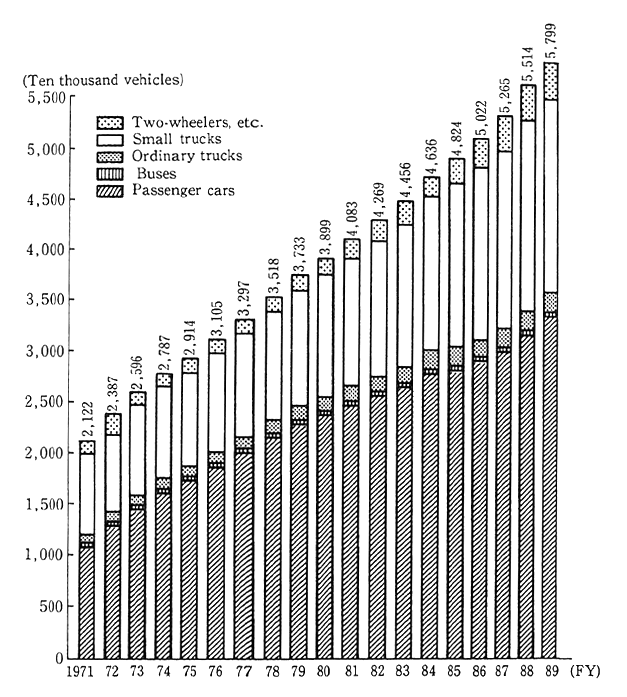
Remarks: 1. Prepared on the basis of the Ministry of Transport's "Statistical Yearbook on Land Transportation."
2. The passenger cars include light passenger cars.
3. The small trucks include light trucks.
Table 5-4-2 Achievement of Environmental Quality Standards for Nitrogen Dioxide at Automobile Exhaust Monitoring Stations in Major Urban Areas (3 Areas with Areawide Total Pollution Load Controls) (FY1988)
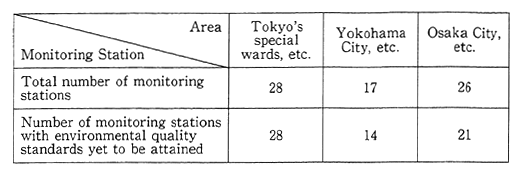
Remarks: Surveyed by the Environment Agency.
As regards nitrogen dioxide, in particular, there remain many monitoring stations the monitored values of which are in excess of environmental quality standards primarily in major urban areas, so that the improvements can hardly be considered satisfactory (Table 5-4-2).
c. In respect of the noise caused by automobiles, in order to grasp the actual situation of points which are deemed to represent the noise of given districts or points where noise-related issues tend to crop up, the findings of monitoring done at 4,508 monitoring points where actual monitoring was done by prefectures, municipalities and special wards in 1988 are given in Fig. 5-4-3. The environmental quality standards as-sociated with noise were attained at 652 points (14.5% of all monitoring points), and the number of monitoring points where the requested limit (the limit defined in Paragraph 1, Article 17 of the Noise Control Law) was 1,265 (28.1% of all monitoring points).
Fig. 5-4-3 Attainment of Environmental Quality Standards and Excesses Over Required Limits (FY1988)
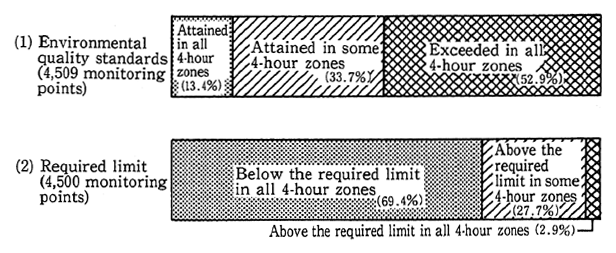
An area-specific illustration on the attainment of environmental quality standards and the surpassing of the requested limit is given in Fig. 5-4-4. The Category 2 areas which were offered for residential purposes and where the assurance of tranquillity was required, the attainment of environmental quality standards was particularly low. The environmental quality standards were attained at 105 points, or 4. 6% of 2,279 points, and the requested limit was surpassed at 918 points, or 40.3%.
An hour-specific illustration on the attainment of environmental quality standards is given in Fig. 5-4-5. Of 4,509 monitoring points, the attainment of environmental quality standards at night was high with 1, 762 points, or 39.1%, whereas the number of monitoring points where the requested limit was surpassed was also great with 1,005, or 22.3%.
Incidentally, as the monitoring periods, the monitoring hours and other factors do not coincide with one another, depending on the year, a simple comparison would not be warranted, but the attainment of environmental quality standards and the surpassing of the requested limit at 989 monitoring points which had used the same spots for monitoring for five consecutive years since 1983 are given in Fig.3-1-14, Part 2. The figure shows no signs of conspicuous improvement, and particularly in major urban areas and in urban areas located along trunk roads which constitute arteries of automobile traffic, there remains many spots whose noise is striking, surpassing the requested limit (Fig. 5-4-6).
Fig. 5-4-4 Achievement of Environmental Quality Standards and Excesses over Required Limits by Area (FY1988)
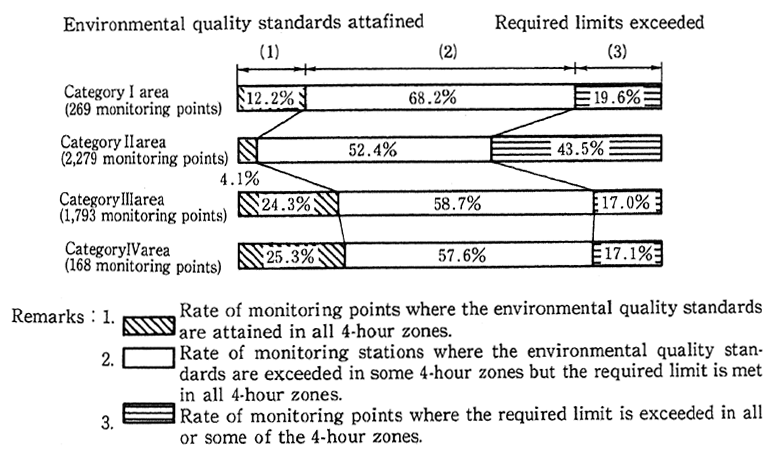
Fig. 5-4-5 Attainment of Environmental Quality Standards and Excesses over Required Limits by Hour (FY1988)
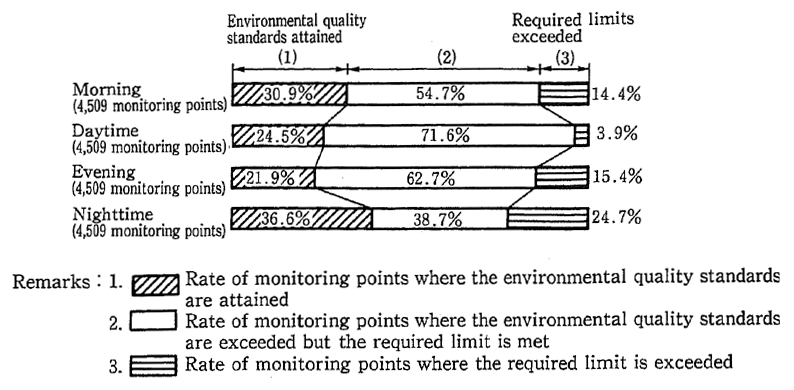
(2) Direction of Measures
a. Environmental Quality Standards and Legal System
Under the provisions of the Basic Law for Pollution Control, the environmental quality standards associated with air pollution and noise are determined, and with those standards as the target, comprehensive measures are implemented for the prevention of road traffic pollution.
Under the Air Pollution Control Law and the Noise Regullation Law, the Director-General of the Environment Agency is empowered to determine the tolerable limits on the quantities of automobile exhaust gas and on the magnitude of noise in order to reduce automobile exhaust gas and noise with improvements in the structure of automobiles. It is stipulated that when the Minister of Transport is to determine neces-sary matters on controls according to the safety standards of road transport vehicles under the Road Transport Vehicle Law, considera-tion be given so that the tolerable limits may be maintained.
It is stipulated that in situations where the monitored level exceeds a certain level, prefectural governors shall request the Prefectural Public Safety Commissions to take measures under the provisions of the Road Traffic Law. It is also stipulated that prefectural govern-ments may express their views to road custodians on matters which will contribute to structural improvements in the given road sections and reductions in the concentration of automobile exhaust gas and the magnitude of their noise, wherever deemed necessary (Fig.5-4-7).
Fig. 5-4-6 Main Points with Excessive Automobile Traffic Noise
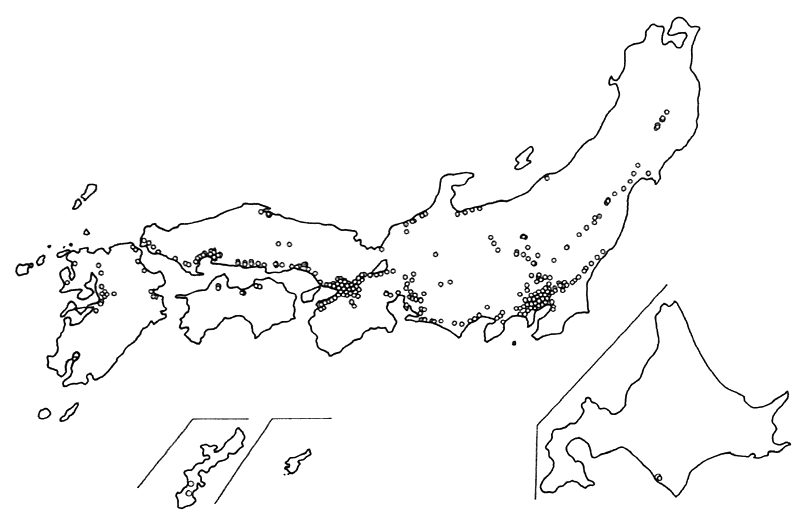
Remarks: Prepared on the basis of the Environment Agency's Fact-finding Survey on Automobile Traffic Noise in FYI988."
Table 5-4-7 Demands and Opinions on Automobile Noise Under Noise Control Law

Remarks: Surveyed by the Environment Agency
Under the Vibration Regullation Law, it is stipulated that the monitored value indicating the vibration caused by road traffic exceeds a certain level and the roadside living environment is deemed signifi-cantly impaired, prefectural governors shall demand the road custo-dians to take measures, such as pavement, maintenance or repair, in order to prevent the vibration on the given road sections, or the Prefectural Public Safety Commissions to take measures under the provisions of the Road Traffic Law.
b. System of Measures
One of the reasons that there are no improvements in air pollu-tion caused by nitrogen oxides primarily in major urban areas concerns the gas exhausted by automobiles. The effects of controls which have been exercised on automobiles themselves are offset because the volume of automobile traffic extremely increases and because the rate of diesel vehicles to trucks, rises, so that the amounts of gas exhausted from automobiles will presumably not drop to a significant degree.
For this reason, there is the need to comprehensively promote measures, including quantitative controls on the traffic of trucks, such as with the rationalization of physical distribution; curbs on the traffic of passenger cars, such as with the development of public means of transportation; the development of bypasses and loops with considera-tion given to the conservation of the environment; structural improve-ments in intersections, and the smoothing of traffic flows, such as with the development of traffic control systems in addition to measures on individual automobiles for curbs on the exhaust of gas from each automobile.
The noise of automobiles themselves comes from their air intake and gas exhaust systems, drive system and tires. The noise of automo-biles is at issue, as it is complicated intertwined with a wide variety of factors, such as the traffic volume, models of vehicles on trips, speeds, road structure and the utilization of roadside land. As regards roadside vibration, the vibration caused by road traffic is at issue with the involvement of such factors as the weight of automobiles, trip condi-tions, the degree of flatness of the road surface, the structure of the pavement, conditions of the road beds and other elements of the road structure.
For drastic solutions to those problems of noise and vibration, there is the need to comprehensively step up various measures, including measures against sources; measures on traffic flows; structural improvements in roads; and measures on roadside neighborhoods, in addition to reductions in the magnitude of vibration with structural improvements in automobiles (Fig.5-4-8).
c. Direction of Measures
As regards measures against road traffic pollution, there is the need to further grapple with measures against nitrogen oxides and other exhaust gas and those against noise, as the volume of automobile traffic is expected to rise, and for the time being, it is necessary to step up measures in the following direction.
(a) Measures Against Nitrogen Oxides and Other Exhaust Gas in Major Urban areas
(1) As measures on individual automobiles, controls on automobile exhaust gas shall be further strengthened and attempts shall be made to promptly shift to less-polluting automobiles, such as those which satisfy the latest controls, as will be elucidated later.
As for electric automobiles, methanol automobiles and other less-polluting automobiles, research and development shall be energeti-cally promoted for further improvements in their performance, and propagation and introduction in each sector shall be stepped up, includ-ing an expansion of their uses.
(2) As regards automobile traffic measures, traffic-flow measures of the sort which will disperse and make smooth traffic shall be compre-hensively and systematically promoted with physical-distribution mea-sures designed to curb the trips of trucks; man-trip measures designed to curb the utilization of passenger cars, such as with a raise in the utility of public means of transportation; the development of loops and so on with consideration given to the conservation of the environment ; and improvements in the structure of intersections.
Fig. 5-4-8 Road Traffic Noise Countermeasures
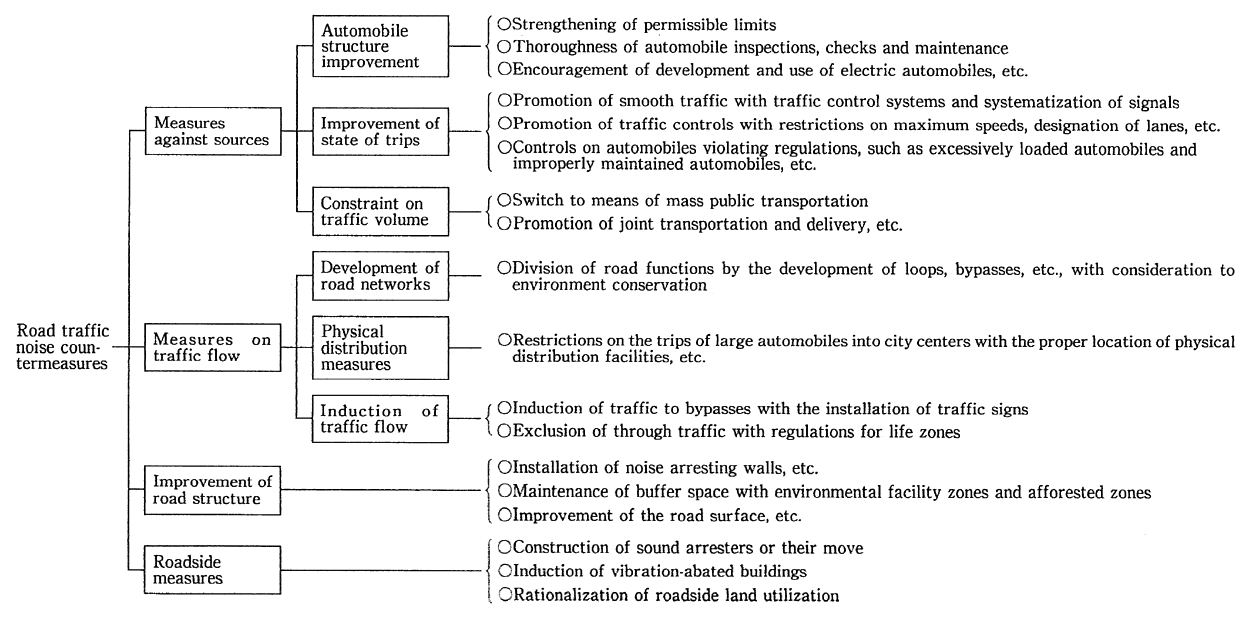
Remarks: Other measures include (1) Implementation of environment quality assessments for the construction and renovation of roads. (2) replenishment of monitoring and surveillance systems, (3) Promotion of the development and research of technology for noise prevention, (4) development of new transportation systems, (5) enlightenment activities for rationali-zation of the use of automobiles, etc.
(b) Measures Against Road Traffic Noise
(1) In areas with specific issues, attempts shall be made to replenish and strengthen conventional measures and to promote measures, such as the subsidization of the construction of noise arresters for dwellings and the increased use of bypasses by large-sized automobiles.
(2) As drastic measures compatible with local features, measures for curbs on the total volume of automobile traffic with the rationalization of physical distribution in major cities; curbs on the flow of large-sized automobiles into city centers, such as by the reasonable location of physical-distribution facilities; and the legitimate utilization of roadside land, will be stepped up. In urban areas along trunk roads, large-sized automobiles shall be restrained from passing through the areas by developing bypasses and other facilities with consideration given to the conservation of the environment.
(3) The enhancement of methods to reasonably maintain, control and drive automobiles and promote the propagation of automobiles lower in noise than ever shall be promoted. Efforts shall be made to develop and step up a wide variety of technologies to reduce noise, and controls on individual automobiles shall be strengthened.
(c) Development of System for Promotion of Measures
Environmental pollution caused by road traffic is extremely tied in with local areas, and for a solution to this issue, it is necessary to formulate effective measures of the sort which is compatible with the local situation by taking advantage of councils and other bodies in which prefectures play the leading role with the involvement of the local branches of the central government. There is also the need for the central government to promote measures it should step up in a system of close liaison and cooperation among related ministries and agencies and support the measures implemented by local governments.
In line with the aforementioned direction, the Environment Agency contributes to the implementation of realistic measures compat-ible with local conditions by instructing prefectures and other organiza-tions about methods to formulate comprehensive programs for the prevention of road traffic noise and carries out surveys in the model areas. As regards measures to cope with nitrogen oxides, the agency plans to promote the programs associated with various traffic and other measures which are formulated for the Tokyo-Yokohama and Osaka-Kobe areas with the target year set at 1990.
In respect of environmental pollution prevention programs under which incorporate measures against traffic pollution as priority mea-sures, the agency makes a point of describing them in more concrete form and work for their more positive promotion. In addition, a wide variety of surveys has been conducted by related ministries and agencies since fiscal 1986 with the use of the fund for the promotion and coordina-tion of comprehensive surveys and researches on the conservation of the environment to work for the promotion of individual projects which are contributory to the conservation of the environment, and on the basis of those findings, it is decided to work for their prompt implementation.
In regard to the dissemination of less-polluting automobiles, monitoring surveys by local governments on the trial use of electric and methanol cars were continuously conducted. In fiscal 1989, less-polluting car fairs were conducted at 4 places and a parade of less-polluting cars was made at 2 places across the country to deepen the people's under. standing about them. In 1988, the Basic Concept on the Dissemination of Less-polluting Automobiles was formulated. Then at the Electric-Car Propagation Promotion Council, Methanol-Car Propagation Promotion Council and other panels, studies on the performance of less-polluting automobiles, research and development and measures for propagation were promoted, and attempts will be made for their more positive promotion with the cooperation of related agencies, such as local governments. For electric and methanol cars, incidentally, exceptional tax measures, such as for the automobile tax and the automobile acquisition tax, have been in force.
With the fund established under the Pollution-related Health Damage Compensation Law, a wide variety of environment improve-ment measures, including the dissemination of less-polluting cars, encouragement of a shift to cars which satisfy the latest controls and the replanting of trees for air purification.
As regards measures against nitrogen dioxides, furthermore,the Environment Agency has formulated a new medium-term prospect with 1993 as the last year primarily for three areas under areawide total pollution load controls to contribute a systematic and comprehensive approach to them. On this basis, the agency is to work for a replenish-ment and strengthening of the conventional measures and to step up studies on new measures, such as curbs on the areawide total volume of automobile exhaust gas, and work for their gradual realization.
(3) Improvements in Automobile Structure
a. Measures Against Exhaust Gas
In respect of nitrogen oxides discharged from automobiles, con-trols began on gasoline and LPG automobiles in fiscal 1973 and on diesel automobiles in fiscal 1974. Later, controls (the 1988 regulation) were put into force on gasoline and diesel passenger cars in line with the initial target value (with the mean exhaust of nitrogen oxides at 0.25 g/km) suggested in the intermediate recommendation made in October 1972 by the Central Council for Environmental Pollution Control, and the crite-rion was a strict one with the value reduced to less than one-tenth that of the years before the start of the controls.
Controls on automobiles (trucks, buses, etc.) other than gasoline and LPG passenger cars were begun in fiscal 1973-74 and gradually reinforced with control measures in 1975 and 1977. Furthermore, the Central Council for Environmental Control suggested two-phase target values for a further reinforcement of controls on nitrogen oxides. The first phase of controls was started as "the 1979 regulation" on all types of automobiles, and the second phase was gradually begun on types of automobiles which could be technically responsive and eventually on all types of automobiles by 1983.
On black diesel smoke exhausted from diesel automobiles, con-trols were started on new automobiles in 1972 and automobiles in the process of use in 1975 with a pollution degree of 50%.
On the exhaust gas of automobiles, controls have been gradually reinforced, as we have just seen, but in major cities and other areas where the traffic volume is significant, further reductions in the exhaust of nitrogen dioxides and particulate matter are required as due to increases both in the number of automobiles and the traffic volume. Given this situation, the Central Council for Environmental Pollution Control was inquired about the way reductions in the exhaust gas of automobiles should be made in the future in November 1985. After deliberations at the Expert Committee on Automobile Exhaust Gas, an interim recommendation was completed in July 1986.
Table 5-4-9 Target Values Set for Permissible Limits
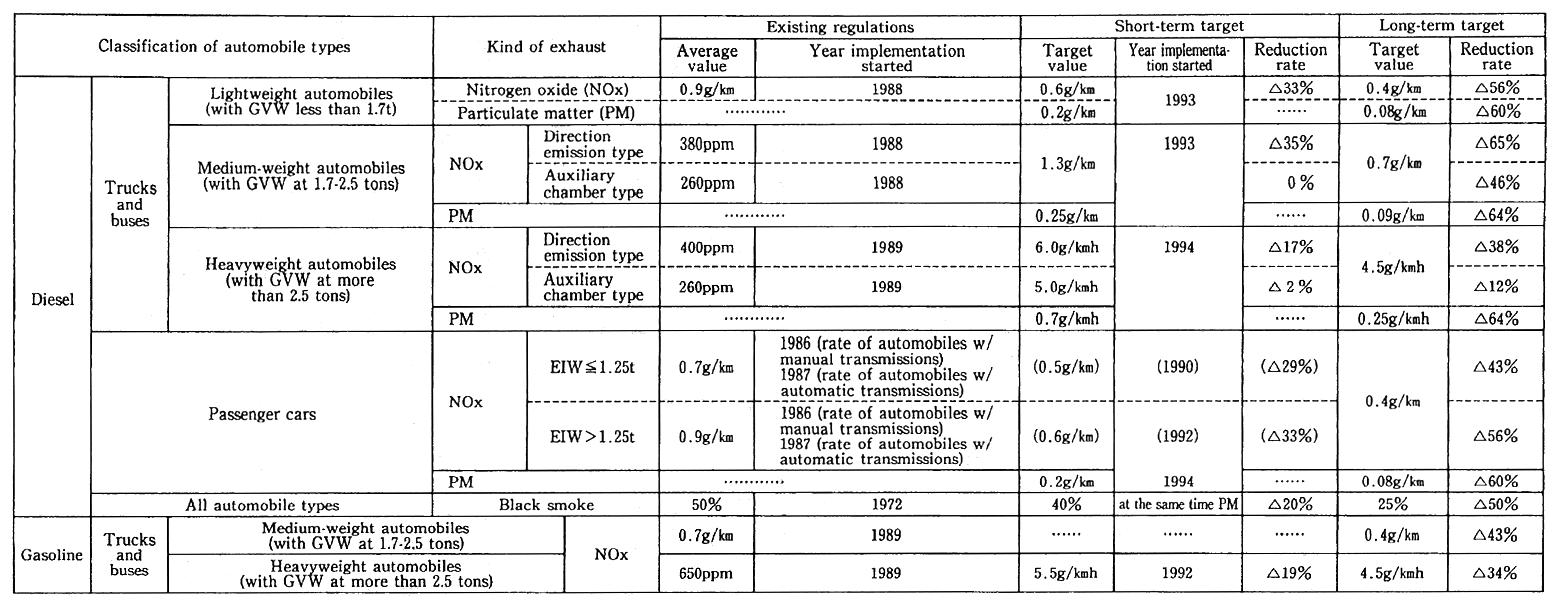
Remarks: 1. The short-term target values for diesel automobiles are those on which public notice was served in December 1988 but not those on which the latest recommendation has been made.
2. GVW: Gross vehicle weight; EIW: Equivalent inertia weight (gross vehicle weight in a situation where the riding of 2 persons is hypothesized with an addition of 110 kilograms to the gross vehicle weight).
3. The reduction rates of nitrogen dioxide are for the values of existing controls both for the long-and short-term target values, and the reduction rate of long-term target values of particulate matter are for short-term target values.
4. The existing control values for black smoke are not average values both for short-and long-term target values. They are maximum values.
5. 0.25 g/kwh is reducible to 0.18 g/PSh, 0.7g/kwh to 0.51 g/PSh, 4.5 g/kwh to 3.31 g/PSh, 5.0 g/kwh to 3.68 g/PSh, 5.5 g/ kwh to 4.05 g/PSh, 6.0 g/kwh to 4.41 g/PSh.
6. It is stipulated that the long-term target values be accomplished as promptly as possible, within 10 years at the latest.
Fir. 5-4-10 NOx Emission Associated with Automobile Exhaust Controls
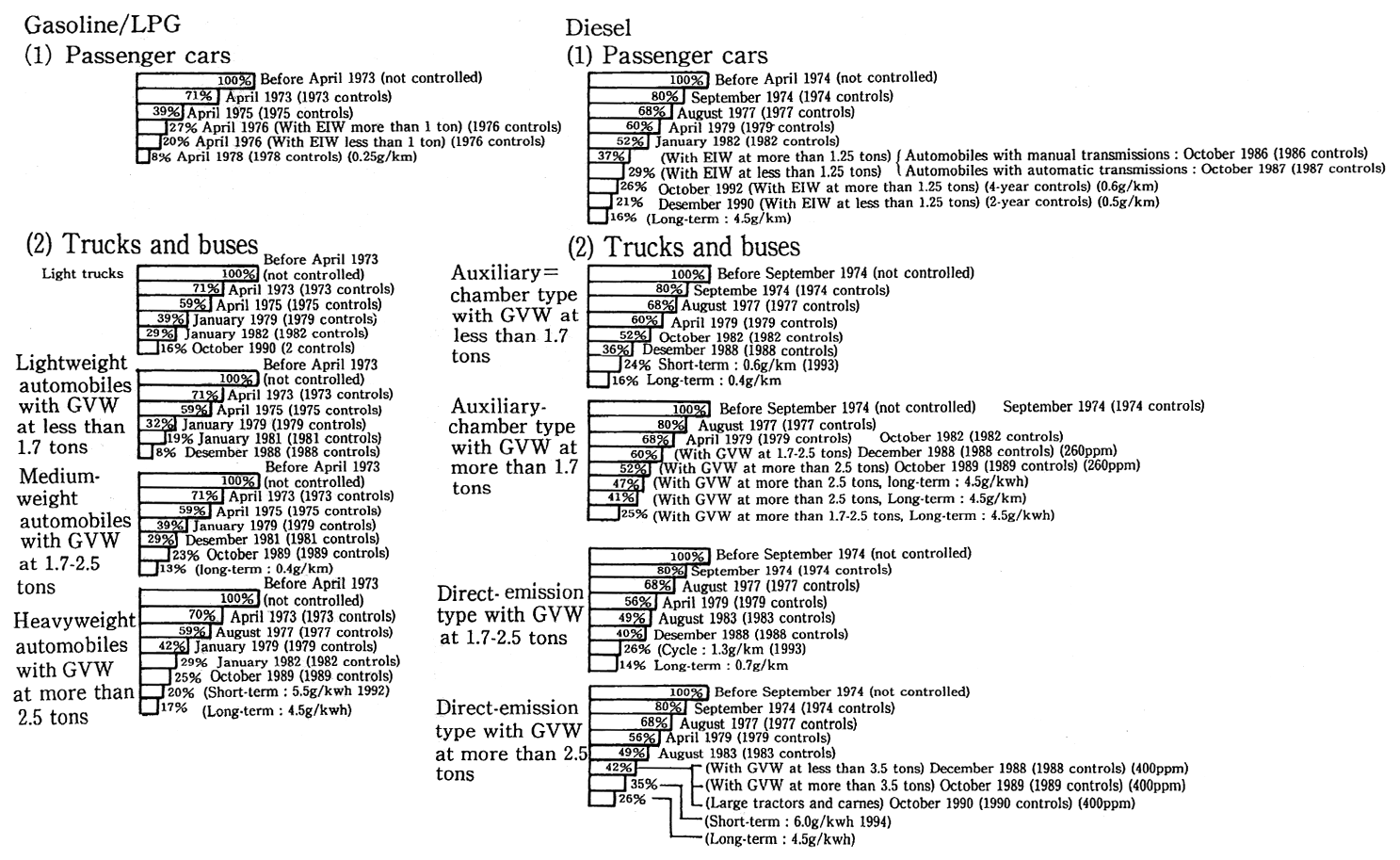
In light of the urgency of measures against nitrogen dioxides, the council suggests in the interim recommendation a 15% cut in the exhaust of nitrogen dioxides from large-sized trucks from the end of fiscal 1988 to that of fiscal 1990, and target reduction values on pickup and other lightweight trucks the controls which were on a par with those of passenger cars. On the basis of this recommendation, tolerable limits and other measures were reinforced in January 1987, and the controls were reinforced from 1988 to 1990. The Central Council for Environmental Pollution Control continued deliberations and completed a recommendation which contained the following measures in December 1990 (Table 5-4-9 and Fig.5-4-10).
(a) Significant Reduction of Nitrogen Dioxides
(1) 30-60% Cut in the Exhaust Levels of Nitrogen Dioxides From Diesel and Other Automobiles
As regards nitrogen dioxides, significant reductions shall be made with the two phases of target values in mind, such as a 38% cut for large-sized diesel trucks (direct injection type) and a 56% cut for diesel passenger cars (medium-sized).
(2) Reduction from Direct Injection Type to Indirect Injection Type
Controls for the direct and indirect injection types shall be inte-grated by reducing the exhaust level of the direct injection type to that of the indirect injection type.
(3) Establishment of Reduction Target Values Designed to Reduce Exhaust Level of Diesel Automobiles to That of Gasoline Auto-mobiles
(b) Drastic Review of Measures Against Particulate Matter
(1) Cut of Upwards of 60% in the Exhaust Level of Particulate Matter for Diesel Automobiles
In addition to conventionally exercised controls on the exhaust level of black diesel smoke, measures for reductions in the exhaust of particulate matter shall be newly incorporated, and the present level shall be reduced by upwards of 60% with the two phases of target values attained.
(2) The exhaust level of black diesel smoke shall be halved with the two phases of target values attained.
(c) Reduction in Sulfur Content in Light Oil
The content of sulfur in light oil associated with measures to reduce nitrogen oxides arid particulate matter shall be reduced to about one-tenth in two phases.
(d) Review of Monitoring Methods
(1) Revision of Maximum Speed in Monitoring Mode
In conjunction with increased trips at fast speed in cities, the maximum speed in the monitoring mode shall be changed to 70 km from the conventional 40 km.
(2) Establishment of Monitoring Mode with Serious Account Taken of Idle and Slow Trips
In conjunction with deteriorating traffic snarls, a new monitoring mode shall be established with idle and low-speed trips taken into account.
(3) Change From Concentration Controls to Weight Controls
With respect to the types of automobiles which are convention-ally controlled on the basis of concentration (large-sized trucks, etc.), controls in terms of weight shall be made by taking serious account of the total volume of exhaust.
(e) Related Measures
As related measures, the encouragement of substitution by new automobiles, the introduction and dissemination of less-polluting auto-mobiles, measures on automobiles in use, traffic measures and measures against fixed source of generation shall be further promoted.
In line with the recommendation, the Environment Agency is to encourage makers to develop technology and work for a gradual rein-forcement of controls on the exhaust gas of automobiles, while striving for as early an achievement of the target values as possible, with the coordination of related ministries and agencies.
As a measure for early improvements in air pollution, it is decided to formulate preferential tax measures, such as cuts in the automobile tax and the automobile acquisition tax and a special redemption system, and to establish a system of low-interest loans for the purchase of replacements, such as from the Japan Development Bank, Smaller Business Finance Corporation and other financial institu-tions so that outdated diesel trucks highly contributory to air pollution may be discarded and replaced by trucks and buses which satisfy the latest criteria of exhaust gas controls.
a. Measures Against Noise
As measures against sources which are designed to the magnitude of noise itself generated from the automobiles with improvements in their structure, automobile noise controls are in force on all automobiles and motorized bicycles.
As measures on new automobiles, first, controls were started in 1971 on the noise of accelerating automobile trips, which was the maximum degree of noise generated by automobile trips in built-up urban areas, in addition to reinforced controls on noise from trips at regular cruising speeds and from exhaust gas. As regards noise from accelerating trips, the controls were strengthened as the 1976 and 1977 regulations, centering on large-sized automobiles the impacts of which were particularly significant and two-wheelers with a large volume of exhaust.
Furthermore, for a further reinforcement of controls on the noise of automobiles (noise from accelerating trips), the Central Council for Environmental Pollution came out with a recommendation, entitled "On Measures for the Long-Term Setting of Tolerable Limits on Automo-bile Noise," suggesting target values in two phases. The first phase of controls based on this recommendation was started as the 1979 regula-tion on all types of automobiles. With the establishment of a panel for the assessment and review of technology for the prevention of automo-bile pollution, the second phase of controls was gradually carried out on those types of automobiles for which there were prospects of a technical response, and it means that controls were exercised on all types of automobiles with the 1985 regulation on large trucks and other vehicles, the noise of which affected the environment and was a significant pending issue, with the 1986 regulation on large-sized trucks and other vehicles and the 1987 regulation on small-sized two-wheelers.
For the prevention of noise, such as by illegal remodeling, con-trols in a nearby exhaust gas monitoring method, which replaced the exhaust noise monitoring method and with which monitoring on the streets was facilitated were started on two-wheelers in June 1986, passenger cars in June 1988 and other four-wheelers in June 1989.
Also on automobiles in use, controls are exercised on noise from trips at regular cruising speeds and on nearby exhaust gas noise.
To guarantee those controls, new and continued inspections are conducted on noise from automobiles. In addition, the on-the-street inspection of improperly maintained vehicles and other measures are taken.
It is also decided to continue implementing required measures for reductions in the noise of the bodies of automobiles.
(4) Traffic Control
It is important to form and maintain smooth and safe traffic flows compatible with local features in the sense of reductions in the air pollution, noise and vibration caused by automobile traffic. The main traffic control measures implemented by police for the prevention of road traffic pollution are as follows:
Attempts are being made to reduce the numbers of starts and stops at intersections with the expansion and sophistication of area for new and existing traffic control centers and more highly sensitive and systematized signals, and by dispersing and guiding traffic flows with the replenishment of functions to offer traffic information, attempts are also being made to reduce nitrogen oxides and carbon dioxide and other exhaust gases responsible for global warming and in noise and vibra-tion.
In cities with a population of upwards of 30,000, efforts are being made to improve the urban environment with the execution of compre-hensive urban traffic controls. The main ingredients are as follows:
(1) With "living zones" in the residential areas designated, controls are being exercised for the living zones with a combination of various traffic controls, including one-way traffic, off-limits to large-sized automobiles and limits on the maximum speed to assure a favorable living environment Particularly in the recent time, as complaints about the noise caused by the driving of "hot rodders": and other menaces, controls on "sound sleep-assured zones" and other measures are im-plemented in an attempt to create an environment where reckless driving is made difficult.
(2) With the designation of lanes with priority given to buses, the introduction of a park and ride system and other measures, a shift from the use of owned cars to mass public means of transportation is encour-aged to strive for curbs on the total volume of automobile traffic.
(5) Improvements in Road Structure and Development of Roadside Environment
As measures to cope with noise, air pollution and the like in terms of road development, road environment of the sort which will create communion and charm with the roadside replanting of trees is being developed to preserve the roadside living environment, in addition to the dispersion and smoothing of road traffic with development of bypasses and loops contributory to the conservation of the roadside environment in built-up urban areas; the adoption of road structure of the kind in which the functions of roads, traffic volume and the utilization of roadside land are taken into account; the elimination of traffic snarls, such as with the construction of overpasses over intersections; the reinforced maintenance and repair of roads; and the development of belts of environmental facilities and noise arresters. In the development of bypasses and so on, environmental impacts are appropriately asses-sed, wherever necessary, to strive for the prevention of environmental pollution.
Under the Law Concerning Sidewalks for Trunk Roads, five routes measuring about 94 km in the aggregate were designated as roads requiring the development of sidewalks as of the end of 1989. Of them, a sidewalk development program was determined for sidewalks, 47.7 km, in 23 areas, including 0.8 km in Nerima Ward for the Metropoli-tan Road Between Kamitakaido and Iwabuchi (Loop 8), and for their realization, the burdening of the cost for the construction of buffer buildings, subsidization of the construction of noise arresters and the advance of noninterest loans to municipalities for the purchase of land are conducted.
For dwellings along national expressways and other highways which are significantly affected by noise, the subsidization of noise-arresting construction work and other measures are carried out as emergency measures, covering about 39,000 dwellings as of the end fiscal 1989.
In addition, road custodians gather and offer traffic information as part of administration on road management and strive for the conservation of the roadside environment, such as with guidance and control on excessively cargo-loaded vehicles. As of the end of fiscal 1988, there were 595,491 cases in which orders were issued to do something about excessively cargo-loaded vehicles.
3. Measures Against Aircraft Noise
The increased availability of jet aircraft, etc., has brought about epochal improvements in the convenience of transport, on the one hand, and given rise to problems of aircraft noise around airports. Particular-ly in conjunction with the urbanization of areas around airports, law-suits were filed demanding a ban on departures and arrivals at night and compensations for damage against the Osaka International Airport and Fukuoka Airport, which are civil airports, and such defense facilities as Komatsu Air Field, Yokota Air Field and Atsugi Air Field.
The dispute over the Osaka International Airport was resolved in March 1984, but other disputes remain outstanding. In regard to the Osaka International Airport, incidentally, an application for arbitration demanding compensations for damage was filed by nearby residents with the Environmental Disputes Coordinating Commission and the arbitration was completed with an arbitration plan presented by the commission by December 1986.
(1) Establishment of Environmental Quality Standards
a. Environmental Quality Standards
The Environmental Quality Standards for Aircraft Noise were determined on December 27, 1973, to serve as the targets of various measures for the prevention of aircraft noise. The standards are designed with the application of types of areas to set the weighed equivalent continuous perceived noise level (WECPNL) at less than 70 for areas offered exclusively for residential purposes and less than 75 for other areas of the sort for which the preservation of ordinary life is required.
It is stipulated that the application of types of areas shall be made by prefectural governors, and as of the end of fiscal 1989, it was done for areas around 54 airports in 31 prefectures.
b. Achievement of Environmental Quality Standards
The deadline for the achievement of environmental quality stan-dards or the attainment of 19-year improvement targets had not been achieved for airports with the exception of a few as of the end of December 1983, but for areas around Tokyo, Osaka, Fukuoka and other airports, there generally were better trends on noise than at the time when the environmental quality standards had been formulated.
(2) Measures Against Sources
The measures against sources are designed to reduce as much noise from aircraft as possible by taking measures about the aircraft which constitute the main source. They are the most basic and effective means in terms of measures against aircraft noise. By promoting measures against sources, such as the introduction of aircraft of a less noisy type and the implementation of aircraft operation systems with reductions in the generation of noise, the areas affected by aircraft noise have been reduced while coping with increases in the volume of air transport.
a. Introduction of Aircraft With Less Noise
A system of certification on compliance with aircraft noise standards, under which the operation of aircraft which gave rise to noise above specified levels would be prohibited, was institutionalized in 1975, and the standards were reinforced in 1978. Civil aircraft with less noise (B-767s, etc.) have been positively introduced primarily for major airports, including the Osaka International Airport where the noise of aircraft is posed as a serious issue, and the decommissioning of aircraft with much noise is promoted. A ban was put, in principle, on the operation in Japan of such aircraft with much noise, as B-7O7s and DC-8s, in January 1988.
b. Controls on Departures and Arrivals
Except at the time of an emergency, a ban is put on the departure and arrival of jet aircraft at the New Tokyo International Airport and Tokyo International Airport from 11 p.m. to 6 a.m. and from 10 p.m. to 7 a.m. at the Osaka International Airport. Furthermore, the Osaka International Airport makes a point of not working out any timetable for regular flights after 9 p.m.
At the Osaka International Airport, the number of aircraft departures and arrivals was set at 370 a day, including 200 for jet aircraft, to reduce the noise of aircraft. Nonetheless, in light of the evolution of measures against sources and those for peripheral areas, the increased operation of jet aircraft at local airports and the necessity of responding to outdated YS-11s, a framework of departures and arrivals (50 times a day) was set for the departure and arrival of the aircraft which would take the place of YS-11s to steadily carry out their replacement as a measure in effect till the opening of the Kansai International Airport with consideration given to the environment. In December 1988, the operation of jet aircraft began in substitute for YS-11s.
c. Operation Systems with Less Noise
Depending on the conditions of location for each airport, a system of priority runways, a system of priority flight routes, a zoom system, a system of cutback assents, a low-flap landing system and a direct-flap approach system are adopted.
(3) Measures Areas Around Airports
For areas which are affected by the noise of aircraft even with the implementation of measures against sources, peripheral-area mea-sures are implemented under the Law Concerning the Prevention, Etc. of Noise From Aircraft in Areas Around Public Airport, among others. The specified airports for which the measures based on this law total 16, including the Tokyo International Airport, Osaka International Airport and Fukuoka Airport. In areas around those airports, noise-arresting construction work for schools, hospitals and dwellings and the develop-ment of facilities for joint use are subsidized, and compensations for moves, the development of green buffer zones and television subscrip-tion fees are subsidized (Table 5-4-12).
The international airports in Osaka and Fukuoka with their peripheral areas urbanized were designated under the law as those for which the systematic development of peripheral facilities were required, and organizations for the development of facilities around the airports were established with capital jointly laid out by the State and related local governments, and renewals, the development of substitute areas and other projects are under way according to programs for the develop-ment of peripheral facilities around the airports formulated by the related prefectural governors.
As a result of the promotion of projects on peripheral measures, the construction of noise arresters for dwellings was virtually completed in fiscal 1985, making it possible to maintain indoor environment of the sort which is specified as targets of the Environmental Quality Standards Associated with Aircraft Noise. By making effective use of sites from which facilities have been moved out, the following measures are taken as it is necessary to work for a harmonious development of airports and peripheral areas.
Fig. 5-4-11 System of Measures on Airport Environment
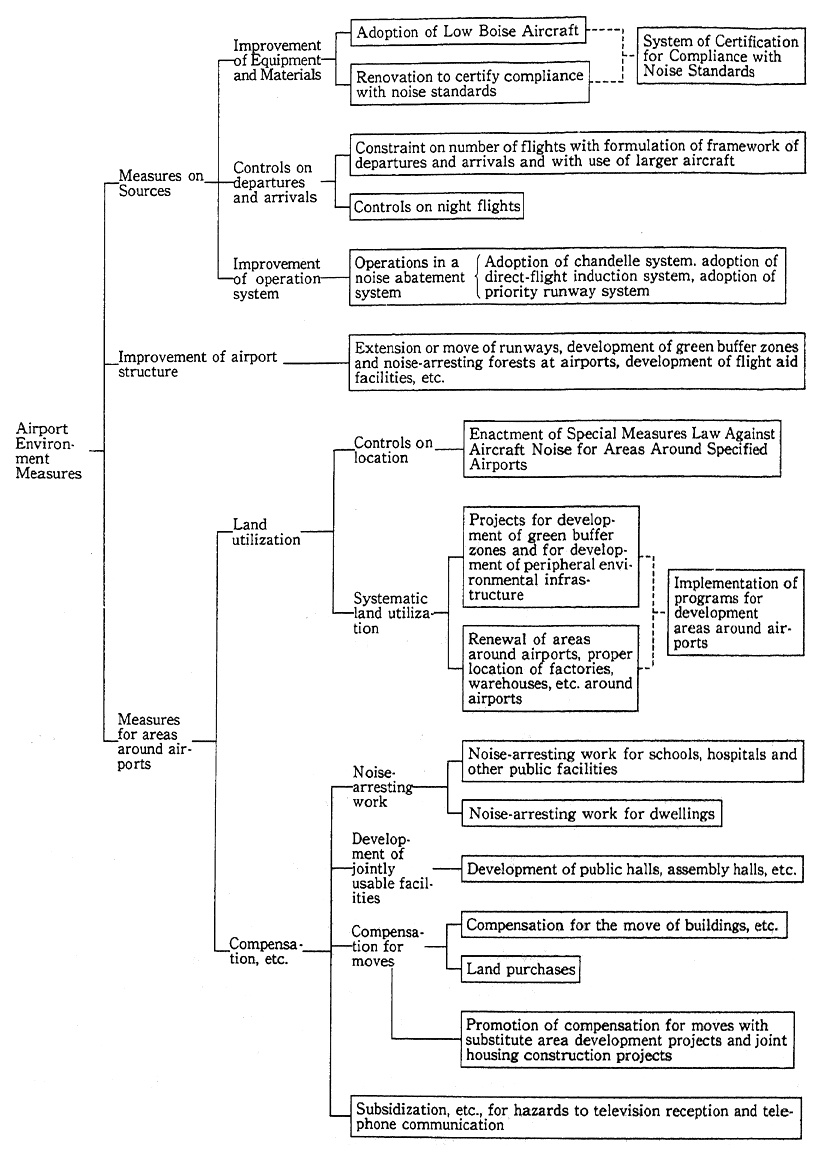
Table 5-4-12 Measures for Areas Around Airports
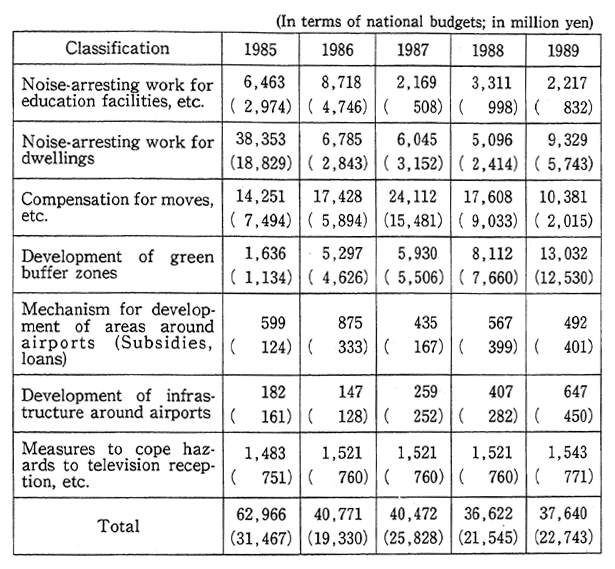
Remarks: 1. Surveyed by the Ministry of Transport.
2. The figures in parentheses are the amounts of budgets for Osaka International Airport.
3. The expenditure for surveys are excluded.
(1) On the Osaka Prefecture side of areas peripheral to the Osaka International Airport, the Ministry of Transport and Osaka Prefecture are to develop about 50 hectares of green land, and its systematic development is under way with a decision under the City Planning Law in February 1987 and an approval and authorization on projects in some sections in January 1988.
(2) In areas around the Osaka International Airport, Fukuoka Air-port and 5 other airports, the development of the peripheral environmen-tal infrastructure, including parks, roads with green, is done by the local governments by taking effective use of the sites from which facilities have been moved out, is subsidized.
Under the Special Measures Law Against the Noise of Aircraft Around Specified Airports, a basic policy on measures against aircraft noise was determined by the Governor of Chiba Prefecture in 1982 to make land utilization harmonious with the New Tokyo International Airport, and according to this policy, city planning is made on areas for which the prevention of aircraft noise is required and other areas.
(4) Measures Against Aircraft Noise in Areas Around Defense Facilities
As regards the noise produced around air fields by aircraft used by the Self-Defense Forces and the U. S. Armed Forces, it is difficult to reduce the sounds of their engines in light of their functions and pur-poses so that measures against noise center on the use of sound arresters and controls on flight patterns. As for measures on sound arresters and flight patterns by the U. S. Armed Forces in Japan, cooperation is called for at the Joint U. 5.-Japan Committee and other panels.
As peripheral measures associated with air fields in use by the Self-Defense Forces and the U. S. Armed Forces, the subsidization of noise arresters for schools, hospitals and dwellings; compensations for the move of buildings and other facilities; land purchases; development of green belts and the subsidization of television subscription fees, etc. are carried out primarily under the Law Concerning the Development, Etc., of the Living Environment in Areas Around Defense Facilities (Table 5-4-13).
Incidentally, as regards 25 areas close to air fields were designat-ed as Category 1 areas under the law as of the end of fiscal 1989, and the subsidization of noise-arresting construction work and other mea-sures are implemented.
As we have just seen, measures and promoted and replenished for areas around air fields in use by the Self-Defense Forces and the U. S. Armed Forces.
Table 5-4-13 Projects Associated with Measures Against Noise around Defense Facilities
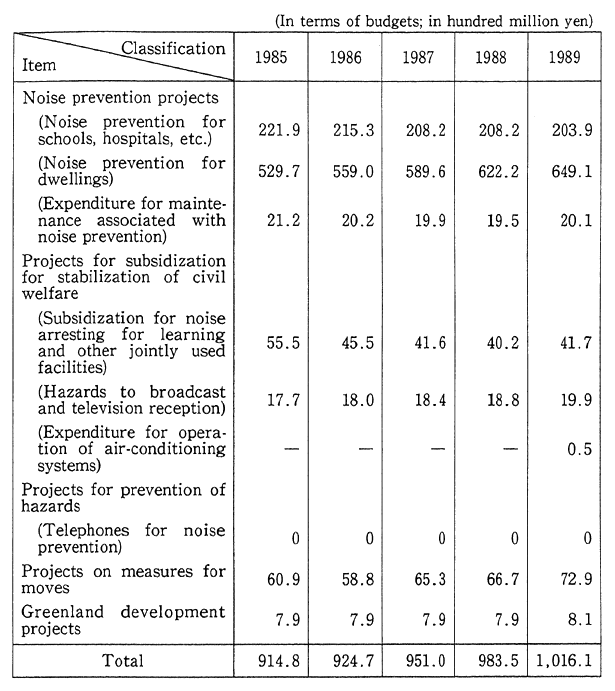
Remarks: 1. Surveyed by the Defense Agency.
2. The figures in the table include some of those for measures other than those against aircraft noise.
3. As each figure is rounded to the nearest whole number, they do not coincide in some cases with the totals in terms of fractions.
4. Measures Against Shinkansen's Noise and Vibration
Since the opening of the Tokaido Shinkansen Line in 1964, the Shinkansen railway system has developed as a means of rapid mass transport, but the noise and vibration produced by its trains in some areas along the lines are posed as a serious problem in terms of environ-ment conservation.
In the Nagoya area, a lawsuit was filed in March 1974 demanding a stop to environmental pollution caused by noise and vibration and compensations for damage in association with the Tokaido Shinkansen Line, but in April 1986, the dispute was settled with a reconciliation which included particularly a further promotion of measures against sources of generation.
a. Environmental Quality Standards
The Environmental Quality Standards for Shinkansen Superex-press Railway Noise which would provide targets for measures to cope with noise produced by Shinkansen were determined on July 19, 1975. Depending on types of areas, the noise level is set under the law at less than 70 dB for areas offered primarily for residential purposes and at less than 75 dB for areas offered for commerce and industry, and it is stipulated that efforts shall be made to achieve or maintain this level.
It is stipulated that the application of types of areas shall be made by prefectural governors, and it is done by all of 21 prefectures through which Shinkansen lines pass.
To contribute to a smooth attainment of the environmental quality standards, the Cabinet approved the General Plan of Measures for Shinkansen Railway Noise Abatement, in which basics on measures against sources and for the prevention of damage, in March 1976, but before the division and privatization of the Japanese National Railways, the Cabinet once approved "On the Promotion of Measures Against the Noise of Shinkansen Trains After the Reform of the Japanese National Railways" in March 1987 50 that the body corporate which would take over the Japanese National Railways' business projects and the Japan Railway Construction Corporation could assure the implementation of the measures incorporated in the General Plan and continue to promote measures against noise.
As for the vibration produced by Shinkansen trains, the Director-General of the Environment Agency recommended the Minister of Transport on "Urgent Measures for Environmental Conseravtion to Cope With Noise by Shinkansen Trains" in March 1976.
b. State of Achievement of Environmental Quality Standards
In regard to the Tokaido and Sanyo Shinkansen Lines, as the last year of a 10-year period by the end of which the environmental quality standards were supposed to have been attained came in July 1985, the Environment Agency checked the attainment. The findings are indicat-ed in Table 5-4-14, suggesting that the standards were not achieved in a considerably many number of areas. On the other hand, noise-arresting construction work in areas with more than 75 dB of noise was complet-ed for dwellings for which requests had been made, and the maintenance of the same indoor environment as was the case with the attainment of the environmental quality standards was fairly realized.
In regard to vibration, the agency checked the attainment of the value of the guideline for measures against vibration based on the recommendation along the Tokaido and Sanyo Shinkansen Lines after a revision of the train timetables in November 1986. The findings are shown in Table 4-1-15. suggesting that the attainment was made in most areas.
With respect to the Tohoku (the section north to Omiya) and Joetsu Shinkansen Lines, as the last year of a five-year period by the end of which the environmental quality standards were supposed to have been achieved came to an end in June and November 1987, respectively, the Environment Agency checked the attainment. The findings are given in Table 5-4-16, suggesting that the attainment was not made in considerably many areas.
Table 5-4-14 Attainment of Environmental Quality Standards for Noise for Tokaido and Sanyo Sinkansen Lines (FY 1985)
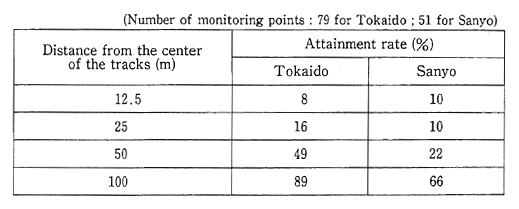
Remarks: 1. Surveyed by the Environment Agency
2. Attainment rate (%) = (Number of attaining monitoring points/num-ber of monitoring points) × 100
Table 5-4-15 Attainment of Recommended Vibration Reading (70 dB) for Tokaido and Sanyo Shinkansen Lines (FY 1986)
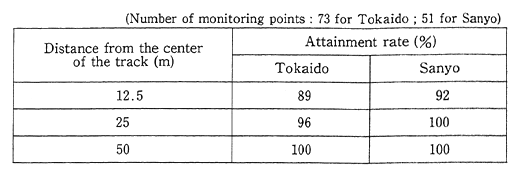
Remarks: 1. Surveyed by the Environment Agency.
2. Attainment rate (%) = (number of attaining monitoring points/num-ber of monitoring points)×100
Table 5-4-16 Attainment of Environmental Quality Standards for Noise for Tohoku and Joetsu Shinkansen Lines (FY 1987)
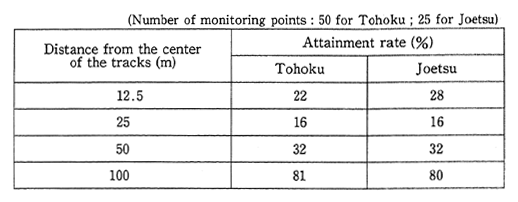
Remarks: 1. Surveyed by the Environment Agency.
2. Attainment rate (%) = (Number of attaining monitoring point/num-ber of monitoring points) × 100
On the other hand, the construction of noise arresters for dwell-ings in areas where the level exceeded 75 dB was completed for dwell-ings for which requests had been made, and the maintenance of the same environment as was the case with the attainment of the environmental quality standards was considerably realized. When vibration was monitored along with noise, the guideline value for measures against vibration (70 dB) had been achieved at all points along the Tohoku and Joetsu lines.